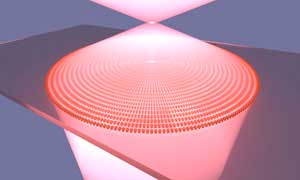| Aug 08, 2018 | |
Flat lenses bring nanoscale features into focus(Nanowerk News) Simple flat lenses, incorporating nanoscale features, that outperform conventional bulk optics have been fabricated by scientists at A*STAR (Nano Letters, "A metalens with a near-unity numerical aperture"). |
|
| High-numerical-aperture optical lenses offer very high resolution and are particularly useful for low-light-intensity applications, such as single-photon optics. The numerical aperture is a measure of the conical angle of light that can be collected by the lens and, reciprocally, how tightly a beam of light can be focused. The larger the numerical aperture, the higher the resolution and the closer the lens can be to the object to be imaged. As the collection angle and, hence the amount of light collected from the object, approaches its theoretical maximum, the numerical aperture increases and gets closer to a value of one, the fundamental maximum for a lens in air. | |
 |
|
| As shown above, a metalens comprising an array of nanoantennas enables tight focusing of red light. (© American Chemical Society) | |
| However, high-numerical-aperture systems can be bulky, complex and expensive. And conventional glass-based optics rarely attain a numerical aperture above 0.95. Scientists from the A*STAR Data Storage Institute have now built a simple flat lens with a numerical aperture higher than 0.99. | |
| “Previous attempts to make flat, high-numerical-aperture lenses ended up with devices that were very inefficient at its edges, where the light bends at very large angles,” explains A*STAR scientist Ramón Paniagua-Domínguez. “We proposed a new method to overcome this limitation using nanoantennas” | |
| The ‘metalens’ created by Paniagua-Domínguez and his colleagues consists of arrays of silicon discs with various diameters on a substrate, each area designed to direct the light at a specific angle. All the areas were engineered to direct light into a specific point — the focus of the lens. The area responsible for giving the lens its high-numerical-aperture comprises pairs of nanometer-scale silicon cylinders, one larger than the other, which act like antennas for visible light. Using silicon rather than a metal reduces losses and makes the concept applicable across a wide range of wavelengths. | |
| The dimensions of the nanoantennas — the disk diameter, disk separation and the pitch of the array — can be altered to suit the metalens’ wavelength range and specific application. For example, disk diameters of 190 and 150 nanometers redirect incoming red light at an angle of 82 degrees. This allowed the team to achieve a numerical aperture of 0.99 in their metalens, making it ideal for high-resolution applications. | |
| “We are exploring more complex geometries to maximize the efficiency of the lens,” says Paniagua-Domínguez. “Plus, seeking other materials to expand the range of frequencies at which the lens works.” |
| Source: A*STAR | |
|
Subscribe to a free copy of one of our daily Nanowerk Newsletter Email Digests with a compilation of all of the day's news. |
